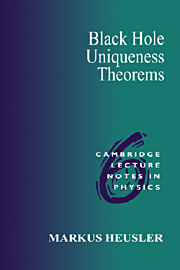Book contents
- Frontmatter
- Contents
- Preface
- 1 Preliminaries
- 2 Spacetimes admitting Killing fields
- 3 Circular spacetimes
- 4 The Kerr metric
- 5 Electrovac spacetimes with Killing fields
- 6 Stationary black holes
- 7 The four laws of black hole physics
- 8 Integrability and divergence identities
- 9 Uniqueness theorems for nonrotating holes
- 10 Uniqueness theorems for rotating holes
- 11 Scalar mappings
- 12 Self–gravitating harmonic mappings
- References
- Index
12 - Self–gravitating harmonic mappings
Published online by Cambridge University Press: 13 March 2010
- Frontmatter
- Contents
- Preface
- 1 Preliminaries
- 2 Spacetimes admitting Killing fields
- 3 Circular spacetimes
- 4 The Kerr metric
- 5 Electrovac spacetimes with Killing fields
- 6 Stationary black holes
- 7 The four laws of black hole physics
- 8 Integrability and divergence identities
- 9 Uniqueness theorems for nonrotating holes
- 10 Uniqueness theorems for rotating holes
- 11 Scalar mappings
- 12 Self–gravitating harmonic mappings
- References
- Index
Summary
In this chapter we establish the uniqueness of the Kerr metric amongst the stationary black hole solutions of self–gravitating harmonic mappings (scalar fields) with arbitrary Riemannian target manifolds. As in the vacuum and the electrovac cases, the uniqueness proof consists of three main parts: First, taking advantage of the strong rigidity theorem (see section 6.2), one establishes staticity for the nonrotating case, and circularity for the rotating case. One then separately proves the uniqueness of the Schwarzschild metric amongst all static configurations, and the uniqueness of the Kerr metric amongst all circular black hole solutions.
The three problems mentioned above are treated in the first section and the last two sections, respectively: The staticity and circularity theorems are derived from the symmetry properties of the scalar fields and the general theorems given in sections 8.1 and 8.2. The static uniqueness theorem is then proven along the same lines as in the vacuum case, that is, by means of conformal techniques and the positive energy theorem. The uniqueness theorem for rotating configurations turns out to be a consequence of the corresponding vacuum theorem (see chapter 10) and an additional integral identity for stationary and axisymmetric harmonic mappings.
Besides dealing with general harmonic mappings, we shall also pay some attention to ordinary scalar (Higgs) fields. By this, we mean harmonic mappings into linear target spaces with an additional potential term in the Lagrangian. By 1972, Bekenstein had already established the static no–hair theorem for ordinary massive scalar fields, by means of a divergence identity.
- Type
- Chapter
- Information
- Black Hole Uniqueness Theorems , pp. 205 - 229Publisher: Cambridge University PressPrint publication year: 1996

